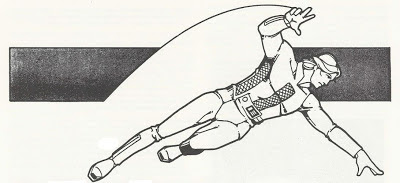In last week's installment, we discussed Skill Spheres in Martin Wixted's Year of the Phoenix. Aside from Skill Spheres, Phoenix characters are also defined by a measurement called Conditioning (abbreviated CON%). Essentially, Conditioning represents physical fitness; in terms of another RPG, it is a combination of Strength and Constitution. According to page 6 of the Training Manual:
Conditioning affects how well you resist disease, and recover from wounds. A low CON% (20%) indicates a feeble or out-of-shape character, while a high CON% (80%) means a muscular, physically fit character.Phoenix characters have a Conditioning score “between 70%-120%.” Wixted explains that player characters have better-than-average Conditioning because they are “heroes” and have just undergone military training. According to the Gamemaster Screen, the average Conditioning score is 50%.
A character's Muscle (MUS) represents the amount of weight he can lift “without trouble.” This is equivalent to his own weight multiplied by his Conditioning percentage. The amount of damage a character can inflict with “[w]eapons requiring a character's physical ability to wield” (including unarmed attacks) is influenced by Muscle. Wixted provides a chart by which a character's Muscle value can be referenced to provide a number from -1 to +5; this score is the character's Damage Class (DAM). Wixted explains:
Since Phoenix Special Forces undergo severe training, they average a higher DAM than normal civilian types, while officers who specialize in physical training...often have appallingly large DAM values.A perusal of the non-player character listings shows that the same 'DAM Chart' is applied to all characters, not just 'Special Forces' personnel. So when Wixted states that Phoenix player characters have a higher than average Damage Class, it is only as a result of their Conditioning scores.
In any event, the Damage Class score is not applied to the results of a damage roll; instead, Damage Class affects the die to be used for determining damage. let us look at an example on page 42 of the Training Guide:
Betty...has a DAM of +5 and is using a hammer which is listed at 1D7. [Actually, hammers are listed at 1D8.] Her hammer does 1D10 + 1D3. She is also using a Knife, listed 1D4+1. [True] Adding her DAM gives her 1D9+1.Wixted writes on page 4 of the Adventure Guide, “Odd-sized dice are easy to extrapolate from the dice included in the game.” (Two ten-sided and two-six sided dice are included.) He explains how to use percentile dice and how to use control dice to – for instance – obtain a 1-20 result from a D6 and a D10. Given the dice that are supplied with the game, we would presumably roll a D10 and ignore results of 8, 9, and 0 so as to replicate the results of a D7. Wixted's interpretation of a 'virtual' D13 as 1D10 + 1D3 is peculiar; the range of results is 2-13 rather than 1-13 and the probability distribution is not flat. Normally, a D20 is used for determining hit location; however, 1D13+7 is used for kick attacks. This is mentioned on the same page as the example of Betty and her hammer. A flat distribution from one to thirteen makes sense for the hit location of kicks; however, with the 1D10 + 1D3 method, right arms are five times more likely as left arms to be hit by kicks. Ah, it seems I digress.
Another measurement associated with Conditioning is the concept of Ergs. The same roll used to determine a character's 'base' number of Ergs also determines a character's level of Conditioning. “Ergs are units of energy,” Wixted notes, “your hero's ability to perform strenuous and/or stressful activities for long periods of time – your character's wind.” A character's score in Ergs establishes how many times – without resting – the character can perform a 'fatiguing action' before suffering detrimental effects. On page 34 of the Training Guide, Wixted rhetorically asks what constitutes a fatiguing action. He answers, “Mechanically, it's any action requiring a die roll.” So, in terms of combat, each attack is a fatiguing action. When a character performs a number of fatiguing actions so that his Erg score is exceeded, he incurs a Difficulty Die Penalty. This penalty is cumulative for every multiple of the Erg score exceeded without a 'meaningful rest.' The 'Erg Action Track' appears on the right edge of the character sheet; Wixted recommends that players use a D6 to mark their position on the track with the facing of the die indicating the Difficulty level. The die is set at the maximum number of Ergs for the character (excess Erg boxes are crossed out) and 'counts down' as actions are performed. Characters can also 'lose Ergs' due to damage they sustain.

Really enjoying this series. I used to own this game back in the day. What happened to Mr Wixted?
ReplyDeleteIt seems Mr Wixted passed away in 1994.
Delete